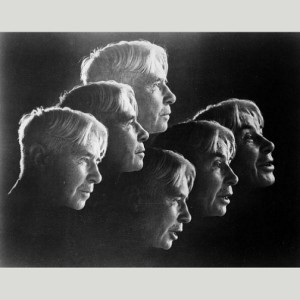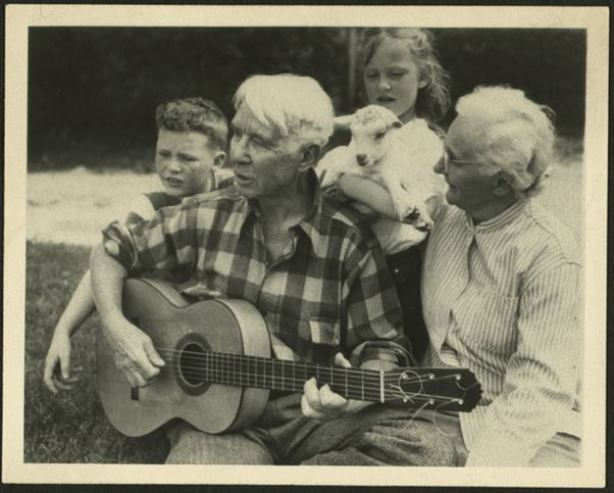By Steve Thornton
At one time, nationally acclaimed poet Carl Sandburg was so popular in Connecticut that even his goats made the news. After his death in 1967, a kennel in Washington, Connecticut, bought some of Sandburg’s herd. The goats—Babette, Coty, and Tenu—eventually returned to North Carolina when Sandburg’s home became a national historic site. Today, however, if the general public remembers Sandburg, it is only as the white-haired old man who strummed a guitar and dubbed Chicago the “city of big shoulders.”
Born in 1878 to Swedish immigrants, Carl Sandburg was a working-class boy who never forgot his roots. His father was a blacksmith for the Chicago railroad who took part in labor causes, including strikes. Sandburg recalled these formative events and considered himself a “partisan” who “took a kind of joy in the complete justice of the strikers” when he was only ten years old.
In his twenties Sandburg was a regular contributor of news and poetry to the International Socialist Review (ISR) and other prominent liberal and radical magazines. With his work for the Chicago Daily News, he honed his skill as a reporter who wrote in the language of the working class.
In true muckraking tradition, Sandburg exposed the 1915 Eastland steamer tragedy in Lake Michigan. The ship capsized, killing 800 workers on their way to a company picnic. Sandburg discovered that the seamen’s union protested the lack of local regulations and quality inspections for years. He further revealed that the “picnic” was a mandatory event—forcing workers to buy a ticket or potentially lose their jobs.
Sandburg in Connecticut
The College Club of Hartford may have been the first to invite Sandburg to Connecticut. On February 3, 1922, he performed at the Center Church House on Gold Street. His lecture was entitled, “Is there a New Poetry?” (Tickets sold for one dollar at Mitchell’s Book Shop around the corner from the church.) Sandburg recited “The Windy City,” which had not yet been published, and sang some of the many folk songs that eventually appeared in his collection, The American Songbag.

Edward Jean Steichen, Carl Sandburg, photographic montage, 1936. © Joanna T. Steichen – National Portrait Gallery, Smithsonian Institution
In January 1932, Sandburg gave readings at Hartford’s Weaver High School, Bulkeley High, and West Middle School for several thousand students, faculty, and members of the public. He spoke frequently at Wesleyan University and received an honorary degree there in 1940, the year he won his first Pulitzer Prize (for Lincoln: The War Years). Sandburg shared the stage in Middletown with Supreme Court Justice William O. Douglas and artist Grant Wood. A few days later, he was in New Haven, receiving another honor from Yale University along with New York mayor Fiorello LaGuardia and philosopher Paul Tillich.
The poet’s body of work became widely known and celebrated throughout the state; as he completed new books, they immediately moved up the charts at local booksellers. In November 1948, Sandburg’s Remembrance Rock was on the fiction best-seller list of Hartford’s eight bookstores. By the 1950s Sandburg no longer toured the country, but his works remained as popular as ever. In 1959, Bette Davis and her husband, actor Gary Merrill (who was born in Hartford), performed Sandburg’s work at Bushnell Memorial Hall.
A Moral Compass for America
Sandburg supported the Industrial Workers of the World (IWW or the Wobblies) and his admiration for this radical union frequently appeared in his writing. Sandburg filled his first three published collections, Chicago Poems (1916), Cornhuskers (1918), and Smoke and Steel (1920), with IWW references, along with sympathetic portraits of immigrants, farmers, factory workers, and the poor. He considered himself “an I.W.W. without a red card.”

Photograph of Carl Sandburg as he prepares for the second of CBS’ documentary shows on the finding of the Robert Todd Lincoln collection of Abraham Lincoln’s papers at the Library of Congress. © CBS WTOP Newsphoto Service – Library of Congress Archives: Photographs, Illustrations, Objects
He earned a reputation as a political and moral compass for many people in public life. As Secretary of Welfare in the Kennedy administration, Abraham Ribicoff considered Sandburg’s Lincoln an inspiration. Connecticut senator Lowell Weicker quoted Sandburg during the Watergate hearings to encourage Richard Nixon to voluntarily testify before Congress.
In addition to the previously mentioned connections to Connecticut, Sandburg also counted a Connecticut governor as his friend. Fellow poet and Wesleyan faculty member Wilbert Snow knew Sandburg for 50 years. Snow became Connecticut Lieutenant Governor in 1945. He served as governor for 13 days when sitting governor Raymond Baldwin resigned to take his newly-elected position in the US Senate. Snow said Sandburg “found poetry not among the rills and rivers of the countryside but in the smokestacks of the city.” Sandburg once told Snow that he “cried for an hour” after he finished writing his six-volume Abraham Lincoln biography. Some years after completing the Lincoln work Sandburg wrote: “Poets cry their hearts out. If they don’t they ain’t poets.”
An Improbable Connection with Wallace Stevens
Hartford author and poet Wallace Stevens met Sandburg in their early Chicago days. The famously reserved vice president of the Hartford Accident and Indemnity Company so impressed Sandburg that Sandburg dedicated the poem “Arms” to Stevens. In the poem, Sandburg learns that the French impressionist Renoir (who died in 1919) kept a rigorous daily schedule of painting despite arthritis that seriously crippled his hands. In the last stanza, Sandburg writes that when the two poets meet again, “I will ask you why Renoir does it / And I believe you will tell me.” This tribute to Stevens was not published until 1993.
Sandburg described Stevens (but not by name) in a newspaper series that recorded his 1932 national lecture tour. “I sat in the home of a Business-man author (there is such an animal!) in Hartford Conn.,” Sandburg wrote. He described Stevens as “conservative in his political and economic views” but concerned about how “lady luck” dominated the fate of the middle and working class as they struggled through the Great Depression.
Is Sandburg Still Relevant?
Sandburg’s early detractors labeled his poetry “propaganda” and warned that a poet had no place focusing on issues of the day. In later years, critics called his work dated, almost quaint. But many feel there will always be ideas and events that need a poet’s anger and passion.
In December 2012, in Newtown, Connecticut, twenty-six elementary students and staff were shot to death at the Sandy Hook Elementary School. Carl Sandburg, long dead, responded to the killings. Just a month after the shootings, a previously unknown Sandburg poem was discovered. Found by accident at the University of Illinois, the piece is entitled, “A Revolver.” It begins:
Here is a revolver.
It has an amazing language all its own.
It delivers unmistakable ultimatums.
It is the last word.
A simple, little human forefinger can tell a terrible story with it.
The poem ends: “And nothing in human philosophy persists more strangely than the old belief that God is always on the side of those who have the most revolvers.”
Guns, violence, and war are haunting subjects of Sandburg’s poetry. But they are balanced with the courage and hope of people forced to cope with tragedy and hard times. He writes in The People, Yes:
The people know the salt of the sea
and the strength of the winds
lashing the corners of the earth.
The people take the earth
as a tomb of rest and a cradle of hope.
Who else speaks for the Family of Man?
Though a native of Illinois who lived in North Carolina, Carl Sandburg made many lasting impressions on Connecticut. His numerous personal and professional acquaintances throughout the state, as well as his touring schedule, made him a regular part of Connecticut life in the early 20th century. In addition, through his words, Sandburg painted timeless portraits of ordinary people throughout the country. The manner in which they still resonate makes them identifiable to readers across generations.
Steve Thornton is a retired union organizer who writes for the Shoeleather History Project










